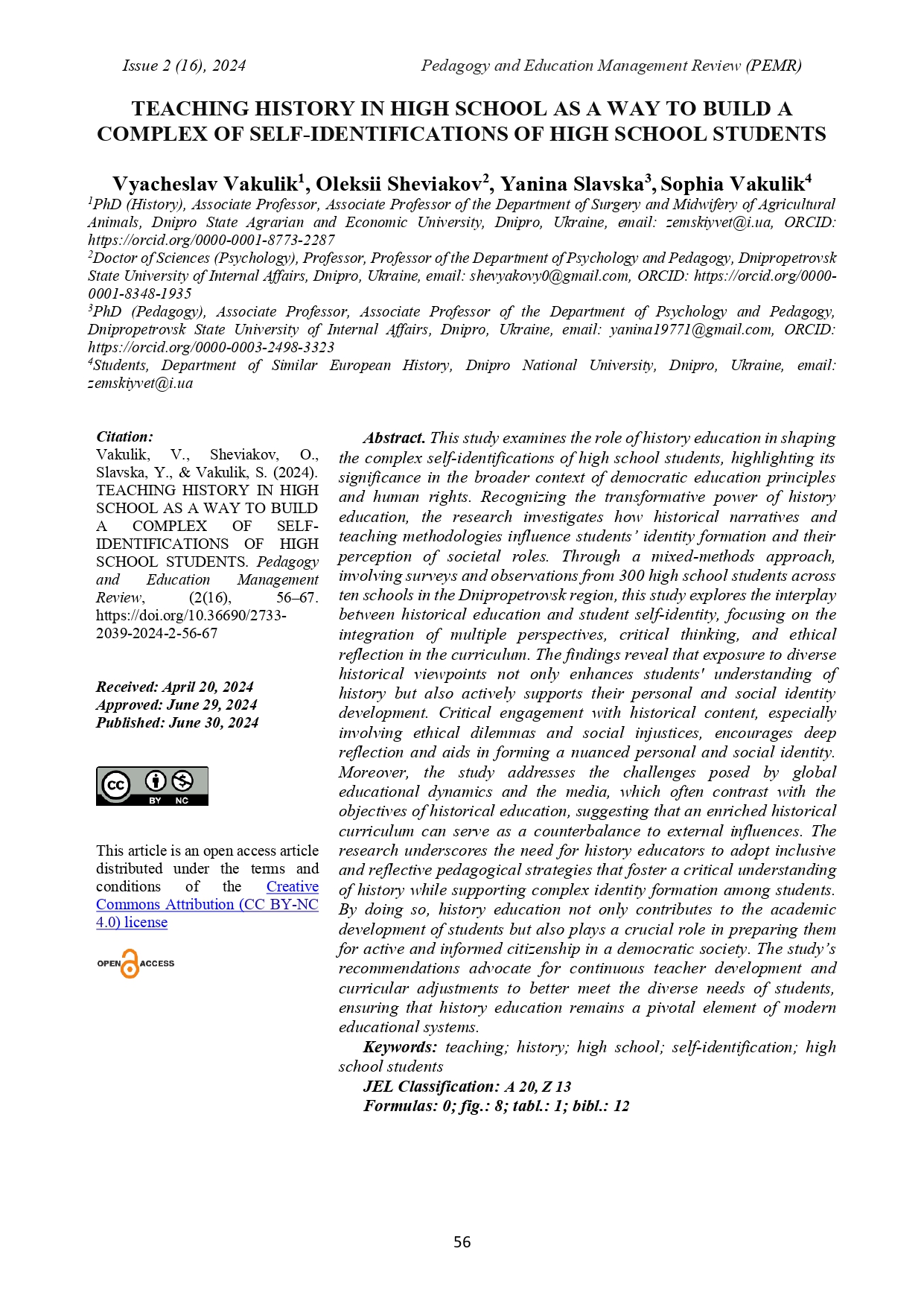TEACHING HISTORY IN HIGH SCHOOL AS A WAY TO BUILD A COMPLEX OF SELF-IDENTIFICATIONS OF HIGH SCHOOL STUDENTS
DOI:
https://doi.org/10.36690/2733-2039-2024-2-56-67Keywords:
teaching, history, high school, self-identification, high school studentsAbstract
This study examines the role of history education in shaping the complex self-identifications of high school students, highlighting its significance in the broader context of democratic education principles and human rights. Recognizing the transformative power of history education, the research investigates how historical narratives and teaching methodologies influence students’ identity formation and their perception of societal roles. Through a mixed-methods approach, involving surveys and observations from 300 high school students across ten schools in the Dnipropetrovsk region, this study explores the interplay between historical education and student self-identity, focusing on the integration of multiple perspectives, critical thinking, and ethical reflection in the curriculum. The findings reveal that exposure to diverse historical viewpoints not only enhances students' understanding of history but also actively supports their personal and social identity development. Critical engagement with historical content, especially involving ethical dilemmas and social injustices, encourages deep reflection and aids in forming a nuanced personal and social identity. Moreover, the study addresses the challenges posed by global educational dynamics and the media, which often contrast with the objectives of historical education, suggesting that an enriched historical curriculum can serve as a counterbalance to external influences. The research underscores the need for history educators to adopt inclusive and reflective pedagogical strategies that foster a critical understanding of history while supporting complex identity formation among students. By doing so, history education not only contributes to the academic development of students but also plays a crucial role in preparing them for active and informed citizenship in a democratic society. The study’s recommendations advocate for continuous teacher development and curricular adjustments to better meet the diverse needs of students, ensuring that history education remains a pivotal element of modern educational systems.
Downloads
References
Banks, J. A. (2008). Teaching strategies for ethnic studies. Allyn and Bacon.
Barton, K. C., & Levstik, L. S. (2004). Teaching history for the common good. Lawrence Erlbaum Associates.
Dunn, R. E. (2010). Bringing the world into the history classroom. Routledge.
Erikson, E. H. (1968). Identity: Youth and crisis. Norton.
Epstein, T. (1998). "Deconstructing Differences in African-American and European-American Adolescents' Perspectives on U.S. History". Curriculum Inquiry, 28(4), 397-423.
Freire, P. (1970). Pedagogy of the oppressed. Herder and Herder.
Loewen, J. W. (1995). Lies my teacher told me: Everything your American history textbook got wrong. The New Press.
Marcia, J. E. (1980). "Identity in adolescence". In J. Adelson (Ed.), Handbook of adolescent psychology (pp. 159-187). Wiley.
Tatum, B. D. (1997). "Why are all the Black kids sitting together in the cafeteria?" and other conversations about race. Basic Books.
Yeager, E. A., & Foster, S. J. (2001). "Creating Irresistible Illusions: Aligning Curricula, Pedagogy, and Teacher Education with Advanced Technologies and Cultural Diversity". Theory & Research in Social Education, 29, 249-282.
Burlakova, I, Sheviakov, O. (2021). Psychologycal predictors of the formation of health-preserving competentmess of future specialists. Public administration and Law Review. 4(8), pp. 74-79.
Sizov V., Sheviakov O., Slavska Ya., Alforov O., Kornienko V. (2022). Theoretical foundations of pedagogy and educations: Collectuve monograf. International Science Groop Boston: Primedia eLaunch. 602 p. P.60-66. DOI-10.4622299/ ISG.2022.







